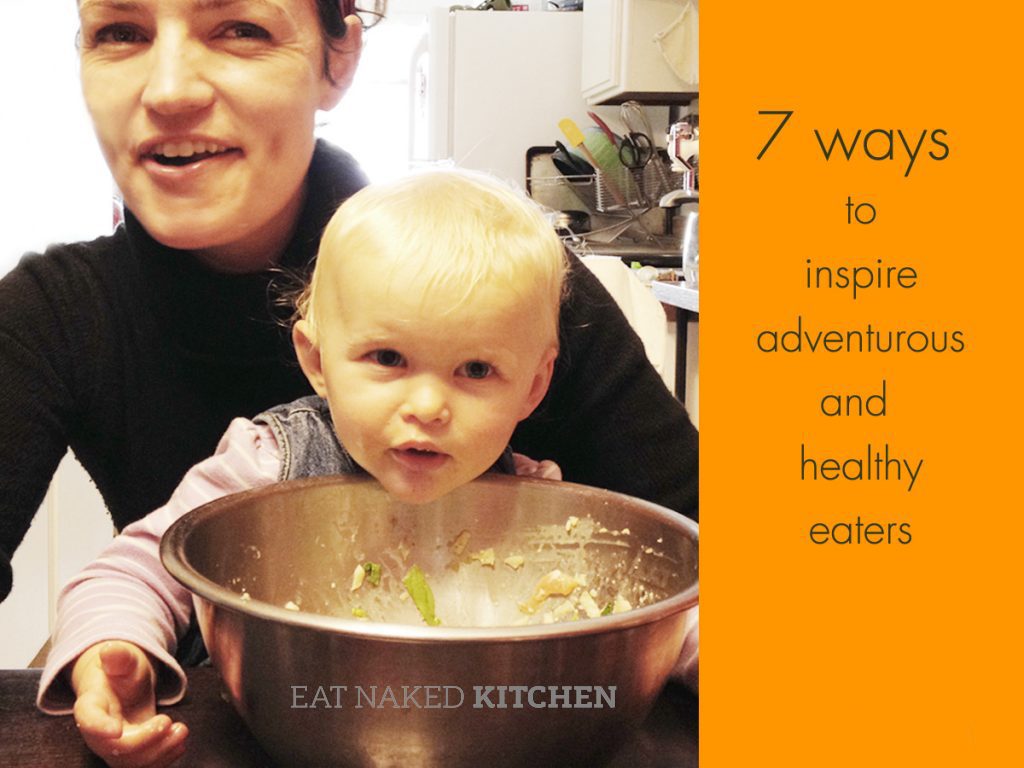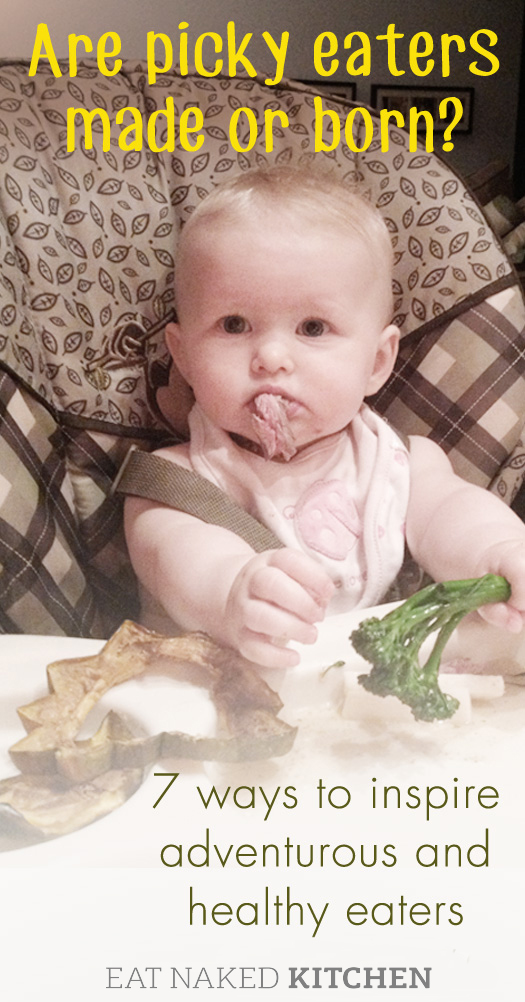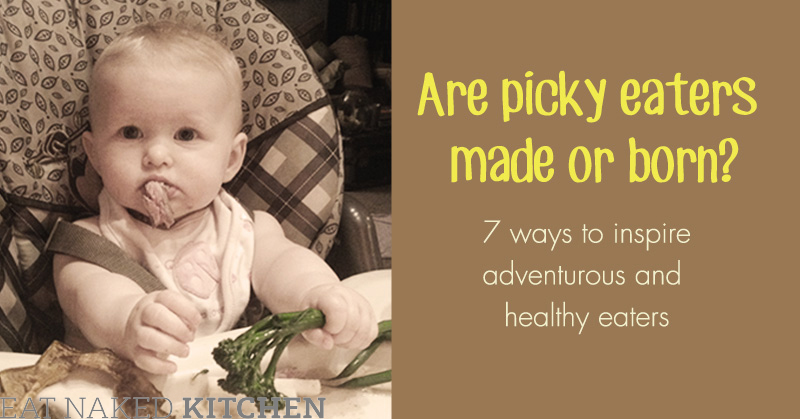Want to stir up a fuss? Post this on your facebook page:
“Picky eaters are made and not born.”
Yeah, I took a lot of heat on that one.
The topic of children and food is certainly a hot button issue for parents. The dinner table as battleground is the frustrating reality for many families.
Vegetable versus dessert.
Parents versus child.
Does it have to be this way?
With only one child who is just approaching toddlerhood, I am clearly no expert. But I like to think that it doesn’t have to be so hard for any of us.
Whether picky eaters are made or born is truly anyone’s guess. Not being willing to take a chance, I was thinking about this issue long before we even conceived.
Here are the top seven strategies we used to inspire our baby girl to be an adventurous and healthy eater.
1) Consider the kinds of foods you want your child to eat right from the moment you conceive. There is increasing evidence showing that whatever mama consumes is tasted by the baby in the amniotic fluid. Want a child who likes the taste of curry? Eat curry while you’re pregnant. Want a child who likes a whole variety of foods? Eat lots of different foods. This applies when you’re breast-feeding, too.
I actively sought out as much diverse-tasting food as I could during most of my pregnancy and while nursing. Lots of strong cultured veggies, gnarly green juices, a whole variety of different ethnic cuisine, lots and lots of flavors for her to feel comfortable with. Did it work? Who knows, but she’s been known to eat Kim Chi for breakfast so something must have sunk in…
2) When it was time to introduce her to solid foods, we used a method called Baby-Led Weaning. For the first month or so of her solid foods, long before she could actually eat anything, we gave her food to play with – to gum, taste, feel, and explore. She would gum a stalk of steamed kale or a stick of zucchini, she would suck on a piece of bloody steak, so much so that she’d suck it dry and grey.
She absolutely loved being at the table with us and being part of meal time, and, importantly, she was also completely in charge of her experience of food. We never forced anything on her, which meant there were no power struggles. When it was time for some puréed foods (and we did do some puréed foods, unlike some more resolute baby-led weaning advocates), we let her play with it, feed herself, and only supplemented with some spoon-feeding to make sure she was getting enough. Usually she’d have her own spoon to play with as well. She loved every minute of it.
3) Only give her foods we’re happy for her to eat and fine if she leaves. What this looks like in practice: no “empty” foods like pastas, crackers, breads, cereals, or anything that’s more filler than nutrient-dense. A typical plate has a bunch of different veggies, some cultured veggies, some meat, eggs or fish, and some good fats – maybe a little avocado, some butter, a slice of cheese. In this scenario, we’re okay if she eats some, all, or none of this meal. We don’t have an agenda and we’ve not given her any starchy foods that she’ll load up on at the expense of the more nutrient-dense counterparts.
When we’ve tested this approach, we see just what we witness other families struggle with. Recently we were out for lunch and gave her some rice in addition to some veggies and fish. Unsurprisingly, she ate the rice, and only the rice. That’s all she wanted. If she hadn’t had the rice on her plate, it wouldn’t have been an option to load up on purely starch.
4) Trust her body’s instincts. When we’re only giving her nutrient-dense foods to choose from, we can trust her body’s instincts. Just like any kid, she’ll love a given food for a few days and then want nothing of it. But as long as all the options available are all good ones, then we’re delighted for her to choose and it’s not a stress. There were weeks when she wouldn’t touch a vegetable other than cultured veggies. Last week that was all she wanted. This summer you couldn’t go past the tomatoes at the grocery store without her pitching a fit to eat one. Now she won’t touch them. Some days she’ll even ask for more fermented cod liver oil!
5) Watch her food consumption over the course of a week rather than a single meal or even a day. This piece of advice was given to me by a dear friend right when we first introduced foods, and then echoed by our pediatrician. It can be tempting to panic when she’s not had any protein in a single day or won’t touch vegetables for days at a time. But if you broaden the horizon to a week’s worth of food rather than a single meal or even a day, it all evens out.
6) We eat what she eats; she eats what we eat. This is a biggie for us. We’re big believers that all food is “kid food” and that you don’t need to shape dinner into a dinosaur for your child to eat it. This means that we eat only those foods we’re happy for her to eat (which means no empty junk for us) and likewise, that she only eats real, whole foods. Even when she was eating purées and liver paté, we’d often eat it right along with her. Sure we may tone down the spice on something (although she loves her spicy foods) but basically we all eat the same thing. And if we’re going to treat ourselves to something we don’t want her to have, we do it after she’s gone to bed, not right in front of her.

More than anything, she wants to be part of what we do. If we’re eating foods that are different from hers, she’s suspicious, and rightfully so. Now, there are exceptions to this rule of course (and actually this was the biggest challenge for us when we did our 30 Days of eating exclusively raw foods)
7) Never make it a fight. This is easier said than done, of course, and we’ve definitely had our moments. When we do all of the above and then just let go, dinner isn’t a fight. Sometimes this means she eats very little. Sometimes it means she eats a ton of one food and leaves the rest on her plate. We let her sort it out.
Ultimately it’s impossible to say how much our efforts influenced our daughter, but we do what we can to create an environment that encourages eating as pleasure rather than a fight.
And the result? We have a healthy baby girl with a huge appetite for all sorts of foods, there are no fights over what she does or doesn’t want to eat, and mealtime is one of the most pleasurable times of our day. Is it just her personality and would all of these efforts be for naught with another child? Only time will tell.
What are YOUR strategies for keeping the peace at dinnertime while encouraging your kids to eat well? Please share in the comments below.

Would you know if your child had nutritional deficiencies? Here’s a great post by Danelle from Weed ’em and Reap on 10 signs of nutritional deficiencies in children.






As the mother of four, and past the toddler years, I would say these strategies generally hold for multiples!
The only thing that would get tricky with a larger family is letting large amounts of food be left…with a big family it is a little more important that food doesn’t get wasted 🙂
Right on, Margaret!
I tried pretty much all of it as much as I could, but I still ended up with a picky toddler who loves nothing more than chocolate. I ate a variety of foods when I was pregnant and while nursing, we did BLW with good foods and he ate pretty much everything until he turned one. Then he started walking, learned to spit out stuff he doesn’t like and started refusing anything that didn’t look like he may want to eat it, and even then he would spit most of it out.
Now he is almost 3 years old and he is slowly starting to try and like new foods, but it’s still far from what it used to be. He was never forced to eat anything he didn’t want nor denied something he did want to eat, and we offered him mostly good stuff.
The thing is, one piece of chocolate was enough to form a very strong attraction to it. So then after that first exposure, if you don’t give your child chocolate he’s asking for, do you really have a non-picky child, or are you just controlling the child’s diet by limiting available food choices?
This is exactly what we do with our one year old but sometimes I really struggle with the food gone wasted. Some foods I can pick up and eat but most of the time she plays and chews on the food so much before she decided she don’t eat it, it’s hard for even me as a mom to nibble after my baby. Over time we just waste so much, what should we do?
@Joyce – I know it can feel hard for the food wasted. I often just eat what she doesn’t (unless she’s already chewed it, in which case I let it go). I’ve found that since I’ve given her so much control, she wastes much less (in terms of throwing it around or chewing and then spitting it out). Just a mouthful here and there as she’s experimenting. I try *very* hard (not always successfully) not to make a big deal out of messes and spills. I find the more I react, the more she wants to do it 🙂
These are good starter strategies, for sure. I would add, also, that you need to be strong through food strikes. A child will not starve themselves to death, they will eat eventually, and it needs to be good food. Another strategy I’ve used as my children have grown is to have them take at least two bites of a food before they say they don’t want it. This gets the taste in their system, and they usually end up liking it later down the line. I’ve found that works for children who were raised to be picky on purpose (my stepkids) as well as those who have been raised on variety. Thanks for this article!